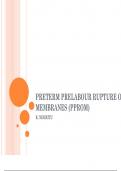exam questions with answer ,class notes
EXCELLENT HOMEWORK HELP AND TUTORING ,ALL KIND OF QUIZ AND EXAMS WITH GUARANTEE OF A
Am an expert on major courses especially; psychology,Nursing, Human resource Management and Mathemtics Assisting students with quality work is my first priority. I ensure scholarly standards in my documents and that's why i'm one of the BEST GOLD RATED TUTORS in STUVIA. I assure a GOOD GRADE if you will use my work.
- 211
- 0
- 1
Community
- Followers
- Following
209 items

PROLONGED PREGNANCY
the term prolonged pregnancy will be used to describe a pregnancy equal to or beyond 42 weeks. Postmaturity refers to a description of the neonate with peeling of the epidermis, long nails, loose skin suggestive of recent weight loss and an alert face (Koklanaris and Tropper 2006). a pregnancy where the gestation exceeds 42 completed weeks (294 days). Simpson and Stanley 2011). Gülmezoglu et al (2012) refer to pregnancies that go beyond 294 ...
- Class notes
- • 24 pages •
the term prolonged pregnancy will be used to describe a pregnancy equal to or beyond 42 weeks. Postmaturity refers to a description of the neonate with peeling of the epidermis, long nails, loose skin suggestive of recent weight loss and an alert face (Koklanaris and Tropper 2006). a pregnancy where the gestation exceeds 42 completed weeks (294 days). Simpson and Stanley 2011). Gülmezoglu et al (2012) refer to pregnancies that go beyond 294 ...

PHYSIOLOGYAND CAREDURINGTHETHIRD STAGE OF LABOUR
PHYSIOLOGICAL PROCESSES The third stage can be defined as the period from the birth of the baby to complete expulsion of the placenta and membranes. It involves the development of the relationship between mother, baby and father, the separation, descent and expulsion of the placenta and membranes, the control of haemorrhage from the placenta site, and sometimes, the initiation of breast-feeding. Although traditionally labour is divided into three distinct componen...
- Class notes
- • 42 pages •
PHYSIOLOGICAL PROCESSES The third stage can be defined as the period from the birth of the baby to complete expulsion of the placenta and membranes. It involves the development of the relationship between mother, baby and father, the separation, descent and expulsion of the placenta and membranes, the control of haemorrhage from the placenta site, and sometimes, the initiation of breast-feeding. Although traditionally labour is divided into three distinct componen...

PHYSIOLOGYAND CAREDURINGTHETRANSITION AND SECONDSTAGEPHASESOF LABOR
The physiological changes are a continuation of the same forces that occurred in the earlier hours of labour, but activity is accelerated, but does not occur abruptly. Some women may experience an urge to push before the cervical os is fully dilated, and other may experience a lull before the onset of strong expulsive second stage contractions. This latter phenomenon has been termed the resting phase of the second stage of labour. T
- Class notes
- • 22 pages •
The physiological changes are a continuation of the same forces that occurred in the earlier hours of labour, but activity is accelerated, but does not occur abruptly. Some women may experience an urge to push before the cervical os is fully dilated, and other may experience a lull before the onset of strong expulsive second stage contractions. This latter phenomenon has been termed the resting phase of the second stage of labour. T

FIRST STAGE OF LABOUR:
FIRST STAGE OF LABOUR: PHYSIOLOGY AND CARE. SESSION 1 R. NDERITU A human pregnancy -last approximately 40 weeks labour usually occurring between 37 and 42 weeks’ gestation (National Institute for Health and Clinical Excellence [NICE] 2007) Complex physiologicaland psychological changes occur during the last few weeks of pregnancy, and also during the onset of labour, that prepare the woman for the process of labour and birth. Labour: process by which expelle...
- Class notes
- • 229 pages •
FIRST STAGE OF LABOUR: PHYSIOLOGY AND CARE. SESSION 1 R. NDERITU A human pregnancy -last approximately 40 weeks labour usually occurring between 37 and 42 weeks’ gestation (National Institute for Health and Clinical Excellence [NICE] 2007) Complex physiologicaland psychological changes occur during the last few weeks of pregnancy, and also during the onset of labour, that prepare the woman for the process of labour and birth. Labour: process by which expelle...

ANAEMIA PREVENTION AND CONTROL IN PREGNANCY
ANAEMIA PREVENTION AND CONTROL IN PREGNANCY ANAEMIA PREVENTION AND CONTROL IN PREGNANCY AIM • To inform participants about the problem of anaemia in pregnancy, its common causes, and prevention and control strategies and to review skills for case management. OBJECTIVES: At the end of the session, participants will be able to: • Describe the problem of anaemia in pregnancy and list its effects on the OBJECTIVES: • Describe strategies for preventing anaemia in pre...
- Class notes
- • 16 pages •
ANAEMIA PREVENTION AND CONTROL IN PREGNANCY ANAEMIA PREVENTION AND CONTROL IN PREGNANCY AIM • To inform participants about the problem of anaemia in pregnancy, its common causes, and prevention and control strategies and to review skills for case management. OBJECTIVES: At the end of the session, participants will be able to: • Describe the problem of anaemia in pregnancy and list its effects on the OBJECTIVES: • Describe strategies for preventing anaemia in pre...

antepartum hemorrhage
antepartum hemorrhage Bleeding from genital tract after 24weeks gestation but before onset of labor TYPES OF APH Placenta praevia Placenta abruption ASSESSMENT OF PHYSICAL CONDITION; Maternal cx. Assess emotional status Pallor, breathlessness(indicate shock) Observe pulse rate respiratory, blood pressure and temperatures Assess amount of blood loss=ensure adequate fluid replacement A gentle abdominal exam is done-observe signs of labour(N/B:-N...
- Class notes
- • 38 pages •
antepartum hemorrhage Bleeding from genital tract after 24weeks gestation but before onset of labor TYPES OF APH Placenta praevia Placenta abruption ASSESSMENT OF PHYSICAL CONDITION; Maternal cx. Assess emotional status Pallor, breathlessness(indicate shock) Observe pulse rate respiratory, blood pressure and temperatures Assess amount of blood loss=ensure adequate fluid replacement A gentle abdominal exam is done-observe signs of labour(N/B:-N...

PRETERM PRELABOUR RUPTURE OF MEMBRANES (PPROM)
PRETERM PRELABOUR RUPTURE OF MEMBRANES (PPROM) R. NDERITU • occurs before 37 completed (preterm) weeks’ gestation, where the fetal membranes rupture without the onset of spontaneous uterine (PRELABOUR/PROM) activity and the consequential cervical dilatation. • affects 2% of pregnancies and placental abruption is evident in 4–7% of women who present with PPROM. • The condition has a 17–32% recurrence rate in subsequent pregnancies of affected women (Svigos et al 2...
- Case
- • 15 pages •
PRETERM PRELABOUR RUPTURE OF MEMBRANES (PPROM) R. NDERITU • occurs before 37 completed (preterm) weeks’ gestation, where the fetal membranes rupture without the onset of spontaneous uterine (PRELABOUR/PROM) activity and the consequential cervical dilatation. • affects 2% of pregnancies and placental abruption is evident in 4–7% of women who present with PPROM. • The condition has a 17–32% recurrence rate in subsequent pregnancies of affected women (Svigos et al 2...

Hypertensive disorders
Hypertensive disorders DEFINE PRE-ECLAMPSIA A type of hypertensive disorder that occurs during pregnancy esp. after 20 weeks gestation(new onset of hypertension) When severe it can escalate to become ECLAMPSIA- convulsive state •It is marked by high blood pressure in women who have previously not experienced high blood pressure before. •High level of protein in urine •Edema of feet, legs and hands, face •Organ injury •It appears late in pregnancy after 20 ...
- Class notes
- • 42 pages •
Hypertensive disorders DEFINE PRE-ECLAMPSIA A type of hypertensive disorder that occurs during pregnancy esp. after 20 weeks gestation(new onset of hypertension) When severe it can escalate to become ECLAMPSIA- convulsive state •It is marked by high blood pressure in women who have previously not experienced high blood pressure before. •High level of protein in urine •Edema of feet, legs and hands, face •Organ injury •It appears late in pregnancy after 20 ...

MINOR DISCOMFORTS IN PREGNANCY
MINOR DISCOMFORTS IN PREGNANCY R. NDERITU Common complains of a pregnant woman that occurs due to physiologic alteration of pregnancy but don’t necessarily signify pathology. • They are mainly caused by hormonal, accommodation, metabolic and/or postural changes. • They subside after delivery and the end of peuperium. • These remain minor as long as they do not pose much risk to the life of the mother and the baby. • Remember: • Minor disorders may escalate a...
- Class notes
- • 54 pages •
MINOR DISCOMFORTS IN PREGNANCY R. NDERITU Common complains of a pregnant woman that occurs due to physiologic alteration of pregnancy but don’t necessarily signify pathology. • They are mainly caused by hormonal, accommodation, metabolic and/or postural changes. • They subside after delivery and the end of peuperium. • These remain minor as long as they do not pose much risk to the life of the mother and the baby. • Remember: • Minor disorders may escalate a...

PSYCHOTROPIC DRUGS
PSYCHOTROPIC DRUGS Structural Classification of the Nervous System Central Nervous System: consist of brain and spinal cord, which act as integrating and command centers of the nervous system. Peripheral Nervous System: it is the part of nervous system outside the CNS. They link all parts of the body by carrying impulses from sensory receptors to CNS and from the CNS to appropriate glands or muscles. Synaptic Transmission Excitatory postsynaptic potentials (EPSP) ...
- Class notes
- • 78 pages •
PSYCHOTROPIC DRUGS Structural Classification of the Nervous System Central Nervous System: consist of brain and spinal cord, which act as integrating and command centers of the nervous system. Peripheral Nervous System: it is the part of nervous system outside the CNS. They link all parts of the body by carrying impulses from sensory receptors to CNS and from the CNS to appropriate glands or muscles. Synaptic Transmission Excitatory postsynaptic potentials (EPSP) ...
